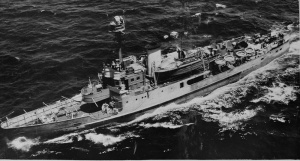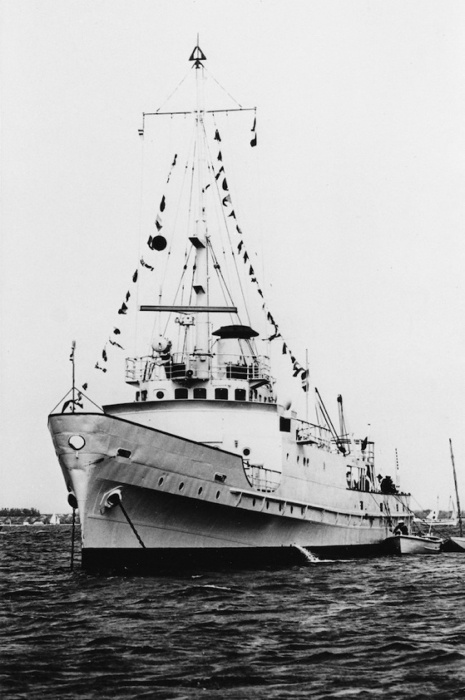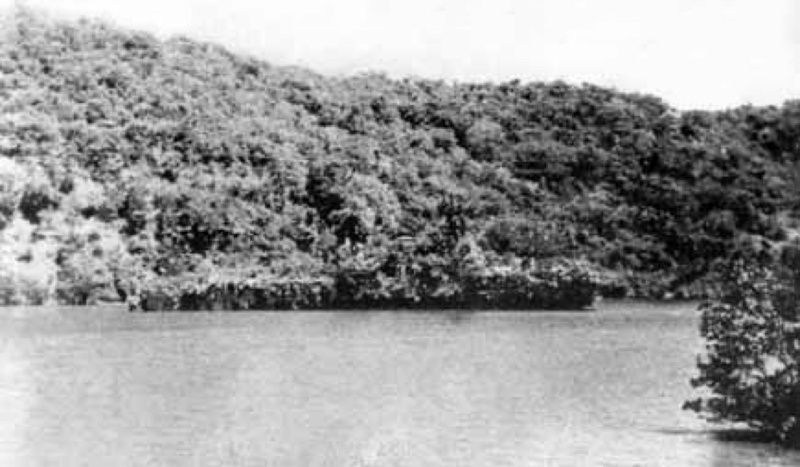HMAS Abraham Crijnssen
| Class |
Jan van Amstel Class |
|---|---|
| Type |
Minesweeper |
| Pennant |
AJ |
| Builder |
Werf Gusto, Schiedam, Holland |
| Launched |
22 September 1937 |
| Commissioned |
26 May 1937 |
| Decommissioned |
5 May 1943 |
| Fate |
Returned to Royal Netherlands Navy |
| Dimensions & Displacement | |
| Displacement | 476 tonnes |
| Length | 56.69 metres |
| Beam | 7.77 metres |
| Draught | 2.11 metres |
| Performance | |
| Speed | 15 knots |
| Complement | |
| Crew | 45 |
| Propulsion | |
| Machinery | Triple expansion engines, two Yarrow 3-drum boilers, twin shafts, 1690 hp |
| Armament | |
| Guns |
|
| Other Armament | Outfit of depth charges |
| Sonars | ASDIC |
| Awards | |
| Battle Honours | PACIFIC 1941-45 |
Abraham Crijnssen was one of eight Jan van Amstel Steel Class mine warfare vessels built for the Royal Netherlands Navy between 1936 and 1939. Other ships of the class included Jan van Amstel, Pieter De Bitter, Eland Dubois, Jan van Gelder, Abraham van der Hulst, Pieter Florisz and William van Ewijck.
At the outbreak of the Pacific war (1941) Abraham Crijnssen and several of her sister ships were operating in the Netherlands East Indies. By February 1942 the situation in Java had become critical as Japanese forces gained air superiority and control of the sea. In the face of crushing naval defeats during the Battles of the Java Sea and Sunda Strait a general evacuation was ordered and the remaining Allied vessels began to withdraw in an attempt to reach Australia. Pieter De Bitter was scuttled at Sourabaya on 2 March to prevent her from falling into Japanese hands, Eland Dubois was scuttled on 8 March and Jan Van Amstel was sunk by the Japanese destroyer Arashio on the same day following an unsuccessful attempt to break through the Lombok Strait into the Indian Ocean. Only Abraham Crijnssen succeeded in escaping, and only by sailing close to the coast at night and hiding, camouflaged with trees and foliage, by day. She eventually reached Fremantle on 20 March 1942. She was the last vessel to successfully escape from Java.
Abraham Crijnssen was transferred to the RAN and commissioned on 28 September 1942 as an anti-submarine escort vessel. Appointed in command was Lieutenant Arthur Irwin Chapman, RANR (S) who wrote of the commissioning some thirty years later:
"I marched on board the Crijnssen with a white ensign under one arm and two framed pictures under the other - one of H.M. King George VI and the other of the actress Rita Hayworth (in a very fetching black negligee). The latter had been in the wardroom of my previous ship and was my property. In the interest of international goodwill it was agreed that HM Queen Wilhelmina of the Netherlands would remain in the Crijnssen's wardroom and so King George was installed in my cabin. It was agreed however that Miss Hayworth was worthy of wardroom status and she was installed on the bulkhead opposite Queen Wilhelmina."
Crijnssen's ship's company comprised one division of Dutch seamen, another division of Royal Navy seamen, some of whom were survivors from HMS Jupiter lost following the Battle of the Java Sea, as well as officers and sailors of the RAN, RANR & RANVR.
Although not designed as an ocean-going vessel, the Abraham Crijnssen performed vital escort duties for convoys on passage along the eastern Australian coast. She was low slung, with a flush deck and shallow draught. This, combined with a heavy steel pole mast with a 20-inch search light mounted on top, all contributed to her pitching and rolling heavily in rough weather. During one period of particularly rough weather in early 1943 Lieutenant Chapman recalled that "it was all we could do to look after ourselves, let alone the convoy". Another of her officers, Sub Lieutenant Marsden Hordern, wrote of the event in his memoirs:
The gale held on stubbornly. The convoy's speed was down to four knots and when two days out from Sydney we were already one day behind schedule. The ships, all out of station, were straggling over the ocean, presenting easy targets for any prowling submarines. Like all gales, this one finally passed, and in gradually abating weather we reassembled our flock and ran on.
On 26 January 1943, while escorting a Sydney bound convoy through Bass Strait, Crijnssen in company with the corvette HMAS Bundaberg made a firm ASDIC contact displaying all the characteristics of a submarine approximately 700 yards on her port beam. Action stations were sounded and orders quickly passed to the engine room to increase to full speed. Two depth charges were hastily dropped over the stern and set to explode at the shallow setting of 50 feet. The resultant explosion sent columns of water soaring into the air and shook Crijnssen violently. A further full pattern of depth charges set to explode at 100 feet was then dropped and oil and scum were observed on the surface. Ordering the convoy to scatter, the two warships then continued to press home the attack, but no wreckage or bodies appeared on the surface and the search was later abandoned. In her attack on the submarine contact, Crijnssen suffered damage to her stern frame and she later spent a week in dry dock on her return to Sydney having all of her sprung centreline rivets replaced.
Lieutenant Chapman wrote of the incident:
The Crijnssen had not picked up sufficient speed from her patrol speed and two depth charges set at 50 feet severely shook up the after section, smashing every bit of crockery, tearing off light switches and fittings and fracturing several minor pipe lines. Queen Wilhelmina crashed to the deck, King George was hanging crazily on one screw but Miss Hayworth was completely secure.
On 5 May 1943 Abraham Crijnssen was officially handed back to the Royal Netherlands Navy. She continued to operate as a convoy escort until 7 June 1945 at which time she deployed to northern Australian waters operating from Darwin. With the cessation of hostilities Abraham Crijnssen swept the passage into Koepang Harbour in Timor for the vessels taking part in the Japanese surrender of that area. Later she was involved in carrying out anti-revolutionary patrols in the Netherlands East Indies (now Indonesia).
In August 1951 the Crijnssen left the East Indies to return to the Netherlands. In March 1956 she was converted to a Boom Defence vessel before finally decommissioning in 1961 and being donated to the Sea Cadet Corps for training purposes. She was berthed at The Hague from 1962-1972 and later moved to Rotterdam. In 1995 the Crijnssen was donated to the naval museum at Den Helder and refitted to her wartime configuration.








